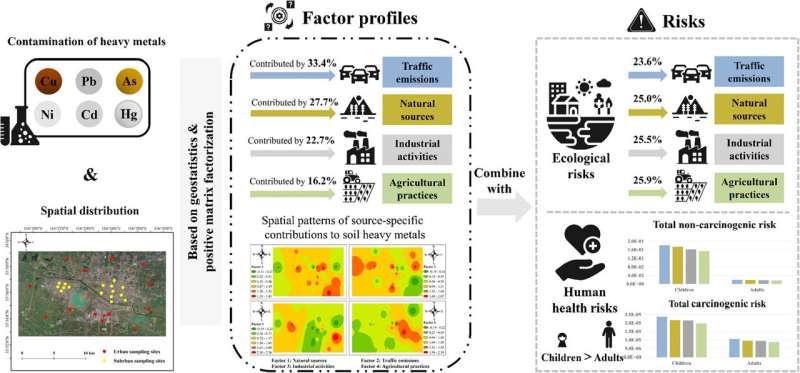Study provides methods for obtaining source apportionment of soil heavy metals
Previous studies have indicated that soil heavy metals (HMs) contaminating the surrounding of mining areas mainly emanates from industrial emissions. However, research on the quantification of specific risks from various sources is still lacking.
In a study published in Science of The Total Environment, researchers from the Xishuangbanna Tropical Botanical Garden (XTBG) of the Chinese Academy of Sciences have investigated the soil HMs contamination and pollution sources in a typical coal industrial city. They quantified the ecological and human health risks of soil HMs from different sources by using a comprehensive approach combining risk assessments with positive matrix factorization (PMF) model.
The study was performed in the core areas of the Yongcheng, a coal-mining city in eastern Henan Province. Thirty soil samples were collected and analyzed for six HMs (Cu, Ni, Pb, Cd, As, and Hg).
The researchers found that the average concentrations of HMs exceeded the corresponding background values, and the study area was moderately contaminated by soil HMs, especially from the accumulation of Cd and Hg. HMs pollution was higher for soils in urban area than soils suburban area.
The specific contributions of four sources, including natural source, traffic emissions, agricultural practices and industrial activities, were apportioned as 27.7%, 33.4%, 16.2% and 22.7%, respectively.
Moreover, the source profiles of potential ecological risks vary in urban and suburban areas. Industrial activities are leading contributions in the urban areas, while agricultural practices contribute mainly to suburban areas.
The non-carcinogenic and carcinogenic risks of children were higher than those of adults, while the contributions of human health risk from different sources were very similar between the two groups. Sources from traffic emissions and natural origin mainly contributed to the non-carcinogenic and carcinogenic risks in the study area, due to the high non-carcinogenicity and carcinogenicity of As and Ni.
“Our findings suggest that the combination of risk assessment models and PMF can be an effective method in obtaining accurate source apportionment of soil HMs,” said Song Liang of XTBG.
Root system significantly affects soil water movement in banana plantation
Xian-Meng Shi et al, Contamination and source-specific risk analysis of soil heavy metals in a typical coal industrial city, central China, Science of The Total Environment (2022). DOI: 10.1016/j.scitotenv.2022.155694
Citation:
Study provides methods for obtaining source apportionment of soil heavy metals (2022, May 13)
retrieved 13 May 2022
from https://phys.org/news/2022-05-methods-source-apportionment-soil-heavy.html
This document is subject to copyright. Apart from any fair dealing for the purpose of private study or research, no
part may be reproduced without the written permission. The content is provided for information purposes only.

Previous studies have indicated that soil heavy metals (HMs) contaminating the surrounding of mining areas mainly emanates from industrial emissions. However, research on the quantification of specific risks from various sources is still lacking.
In a study published in Science of The Total Environment, researchers from the Xishuangbanna Tropical Botanical Garden (XTBG) of the Chinese Academy of Sciences have investigated the soil HMs contamination and pollution sources in a typical coal industrial city. They quantified the ecological and human health risks of soil HMs from different sources by using a comprehensive approach combining risk assessments with positive matrix factorization (PMF) model.
The study was performed in the core areas of the Yongcheng, a coal-mining city in eastern Henan Province. Thirty soil samples were collected and analyzed for six HMs (Cu, Ni, Pb, Cd, As, and Hg).
The researchers found that the average concentrations of HMs exceeded the corresponding background values, and the study area was moderately contaminated by soil HMs, especially from the accumulation of Cd and Hg. HMs pollution was higher for soils in urban area than soils suburban area.
The specific contributions of four sources, including natural source, traffic emissions, agricultural practices and industrial activities, were apportioned as 27.7%, 33.4%, 16.2% and 22.7%, respectively.
Moreover, the source profiles of potential ecological risks vary in urban and suburban areas. Industrial activities are leading contributions in the urban areas, while agricultural practices contribute mainly to suburban areas.
The non-carcinogenic and carcinogenic risks of children were higher than those of adults, while the contributions of human health risk from different sources were very similar between the two groups. Sources from traffic emissions and natural origin mainly contributed to the non-carcinogenic and carcinogenic risks in the study area, due to the high non-carcinogenicity and carcinogenicity of As and Ni.
“Our findings suggest that the combination of risk assessment models and PMF can be an effective method in obtaining accurate source apportionment of soil HMs,” said Song Liang of XTBG.
Root system significantly affects soil water movement in banana plantation
Xian-Meng Shi et al, Contamination and source-specific risk analysis of soil heavy metals in a typical coal industrial city, central China, Science of The Total Environment (2022). DOI: 10.1016/j.scitotenv.2022.155694
Citation:
Study provides methods for obtaining source apportionment of soil heavy metals (2022, May 13)
retrieved 13 May 2022
from https://phys.org/news/2022-05-methods-source-apportionment-soil-heavy.html
This document is subject to copyright. Apart from any fair dealing for the purpose of private study or research, no
part may be reproduced without the written permission. The content is provided for information purposes only.
